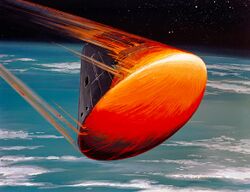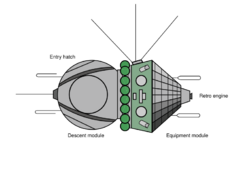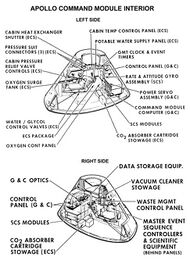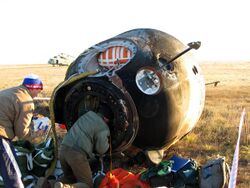Engineering:Space capsule
| It has been suggested that Reentry capsule be merged into this page. (Discuss) Proposed since December 2019. |
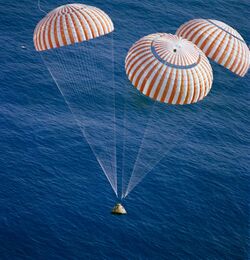
A space capsule is an often-crewed blunt-body spacecraft that reenters the Earth's atmosphere without wings. Capsules are distinguished from satellites primarily by the ability to survive reentry and return a payload to the Earth's surface from orbit. Capsules make up the majority of crewed spacecraft designs, although one crewed spaceplane has launched to orbit.
Current examples of crewed capsules include Soyuz, Shenzhou, Orion, CST-100, and Dragon 2. Future examples of crewed capsules include Orel. Historic examples of crewed capsules include Vostok, Mercury, Voskhod, Gemini, and the Apollo command module. A crewed space capsule must be able to sustain life in the vacuum of space, with an often demanding thermal and radiation environment.
Shape and reentry
Space capsules have typically been smaller than 5 meters (16 feet) in diameter due to launch vehicle aerodynamic requirements. The capsule design is both volumetrically efficient and structurally strong, so it is typically possible to construct small capsules of performance comparable to lifting body or spaceplane designs in all but lift-to-drag ratio for less cost. The Soyuz spacecraft is an example.
Reentry
Most space capsules have used an ablative heat shield for reentry and been non-reusable. The early spacecraft had a coating of glass embedded with synthetic resin and put in very high temperatures.
Space capsules are well-suited to high energy reentries. Capsules reenter aft-end first with the occupants lying down, as this is the optimum position for the human body to withstand the g-forces induced as the capsule impacts the atmosphere. The rounded shape (blunt body) of a capsule forms a shock wave that keeps most of the heat away from the heat shield, but a thermal protection system is still necessary. The space capsule must be strong enough to withstand reentry forces such as drag, and must reenter at a precise angle of attack to prevent a skip off the surface of the atmosphere of destructively high accelerations.
When the space capsule comes through the atmosphere the capsule compresses the air in front of it, which heats up to very high temperatures. The surface temperature of a capsule can reach 1,480 °C (2,700 °F) as it descends through the Earth's atmosphere.[citation needed] To prevent this heat from reaching interior structures, capsules are typically equipped with an ablative heat shield that melts and then vaporizes, removing the heat.
The Apollo command module reentered with the center of mass offset from the center line; this caused the capsule to assume an angled attitude through the air, providing lift that could be used for directional control. Reaction control system thrusters were used to steer the capsule by changing the lift vector.
Parachutes are used for the final descent, sometimes augmented by braking rockets if the capsule is designed to land on the Earth's surface. Examples of land landing capsules include Vostok, Voskhod, Soyuz, Shenzhou and the Boeing CST-100 Starliner. Other capsules, such as Mercury, Gemini, Apollo, Orion, and Dragon, splash down in the ocean.
History
Vostok
The Vostok was the Soviet Union's first crewed space capsule. The first human spaceflight was Vostok 1, accomplished on April 12, 1961 by cosmonaut Yuri Gagarin.
The capsule was originally designed for use both as a camera platform for the Soviet Union's first spy satellite program, Zenit and as a crewed spacecraft. This dual-use design was crucial in gaining Communist Party support for the program. The design used a spherical reentry module, with a biconic descent module containing attitude control thrusters, on-orbit consumables, and the retro rocket for orbit termination. The basic design has remained in use for some 40 years, gradually adapted for a range of other uncrewed satellites.
The reentry module was completely covered in ablative heat shield material, 2.3 meters (7.5 ft) in diameter, weighing 2,460 kilograms (5,420 lb). The capsule was covered with a nose cone to maintain a low-drag profile for launch, with a cylindrical interior cabin approximately 1 meter (3.3 ft) in diameter nearly perpendicular to the capsule's longitudinal axis. The cosmonaut sat in an ejection seat with a separate parachute for escape during a launch emergency and landing during a normal flight. The capsule had its own parachute for landing on the ground. Although official sources stated that Gagarin had landed inside his capsule, a requirement for qualifying as a first crewed spaceflight under International Aeronautical Federation (IAF) rules, it was later revealed that all Vostok cosmonauts ejected and landed separately from the capsule. The capsule was serviced by an aft-facing conical equipment module 2.25 meters (7.4 ft) long by 2.43 meters (8.0 ft), weighing 2,270 kilograms (5,000 lb) containing nitrogen and oxygen breathing gasses, batteries, fuel, attitude control thrusters, and the retrorocket. It could support flights as long as ten days.[1] Six Vostok launches were successfully conducted, the last two pairs in concurrent flights. The longest flight was just short of five days, on Vostok 5 in June 14–19, 1963.[2]
Since the attitude control thrusters were located in the instrument module which was discarded immediately prior to reentry, the reentry module's path and orientation could not be actively controlled. This meant that the capsule had to be protected from reentry heat on all sides, determining the spherical design (as opposed to Project Mercury's conical design, which allowed for maximum volume while minimizing the heat shield diameter).[citation needed] Some control of the capsule's reentry orientation was possible by offsetting its center of gravity. Proper orientation with the cosmonaut's back to the direction of flight was necessary in order to best sustain the which also maximized the 8 to 9 g-force.
Voskhod
The Vostok design was modified to permit carrying multi-cosmonaut crews, and flown as two flights of the Voskhod programme. The cyllindrical interior cabin was replaced with a wider, rectangular cabin which could hold either three cosmonauts seated abreast (Voskhod 1), or two cosmonauts with an inflatable airlock in between them, to permit extravehicular activity (Voskhod 2). A backup solid-fuel retro rocket was added to the top of the descent module. Vostok's ejection seat was removed to save space (thus there was no provision for crew escape in the event of a launch or landing emergency). The complete Voskhod spacecraft weighed 5,682 kilograms (12,527 lb).
Lack of space meant that the crew members of Voskhod 1 did not wear space suits.[3] Both Voskhod 2 crew members wore spacesuits, as it involved an EVA by cosmonaut Alexei Leonov. An airlock was needed because the vehicle's electrical and environmental systems were air-cooled, and complete capsule depressurization would lead to overheating. The airlock weighed 250 kg (551 lb 2 oz), was 700 mm (28 in) in diameter, 770 mm (30 in) high when collapsed for launch. When extended in orbit, it was 2.5 m (8 ft 2 in) long, had an internal diameter of 1 m (3 ft 3 in) and an external diameter of 1.2 m (3 ft 11 in). The second crew member wore a spacesuit as a precaution against accidental descent module depressurization. The airlock was jettisoned after use.
The lack of ejection seats meant that the Voskhod crew would return to Earth inside their spacecraft unlike the Vostok cosmonauts who ejected and parachuted down separately. Because of this, a new landing system was developed, which added a small solid-fuel rocket to the parachute lines. It fired as the descent module neared touchdown, providing a softer landing.
Mercury
The Mercury spacecraft's principal designer was Maxime Faget, who started research for human spaceflight during the time of the NACA.[4] It was 10.8 feet (3.3 m) long and 6.0 feet (1.8 m) wide; with the launch escape system added, the overall length was 25.9 feet (7.9 m).[5] With 100 cubic feet (2.8 m3) of habitable volume, the capsule was just large enough for a single crew member.[6] Inside were 120 controls: 55 electrical switches, 30 fuses and 35 mechanical levers.[7] The heaviest spacecraft, Mercury-Atlas 9, weighed 3,000 pounds (1,400 kg) fully loaded.[8] Its outer skin was made of René 41, a nickel alloy able to withstand high temperatures.[9]
The spacecraft was cone shaped, with a neck at the narrow end.[5] It had a convex base, which carried a heat shield (Item 2 in the diagram below)[10] consisting of an aluminum honeycomb covered with multiple layers of fiberglass.[11] Strapped to it was a retropack (1)[12] consisting of three rockets deployed to brake the spacecraft during reentry.[13] Between these were three minor rockets for separating the spacecraft from the launch vehicle at orbital insertion.[14] The straps that held the package could be severed when it was no longer needed.[15] Next to the heat shield was the pressurized crew compartment (3).[16] Inside, an astronaut would be strapped to a form-fitting seat with instruments in front of him and with his back to the heat shield.[17] Underneath the seat was the environmental control system supplying oxygen and heat,[18] scrubbing the air of CO2, vapor and odors, and (on orbital flights) collecting urine.[19][n 1] The recovery compartment (4)[21] at the narrow end of the spacecraft contained three parachutes: a drogue to stabilize free fall and two main chutes, a primary and reserve.[22] Between the heat shield and inner wall of the crew compartment was a landing skirt, deployed by letting down the heat shield before landing.[23] On top of the recovery compartment was the antenna section (5)[24] containing both antennas for communication and scanners for guiding spacecraft orientation.[25] Attached was a flap used to ensure the spacecraft was faced heat shield first during reentry.[26] A launch escape system (6) was mounted to the narrow end of the spacecraft[27] containing three small solid-fueled rockets which could be fired briefly in a launch failure to separate the capsule safely from its booster. It would deploy the capsule's parachute for a landing nearby at sea.[28] (See also Mission profile for details.)
The Mercury spacecraft did not have an on-board computer, instead relying on all computation for reentry to be calculated by computers on the ground, with their results (retrofire times and firing attitude) then transmitted to the spacecraft by radio while in flight.[29][30] All computer systems used in the Mercury space program were housed in NASA facilities on Earth.[29] The computer systems were IBM 701 computers.[31][32]
The US launched its first Mercury astronaut Alan Shepard on a suborbital flight almost a month after the first crewed orbital spaceflight. The Soviets were able to launch a second Vostok on a one-day flight on August 6, before the US finally orbited the first American, John Glenn, on February 20, 1962. The United States launched a total of two crewed suborbital Mercury capsules and four crewed orbital capsules, with the longest flight, Mercury-Atlas 9, making 22 orbits and lasting 32 and one-half hours.
Gemini
Many components in the capsule itself were reachable through their own small access doors. Unlike Mercury, Gemini used completely solid-state electronics, and its modular design made it easy to repair.[33]
Gemini's emergency launch escape system did not use an escape tower powered by a solid-fuel rocket, but instead used aircraft-style ejection seats. The tower was heavy and complicated, and NASA engineers reasoned that they could do away with it as the Titan II's hypergolic propellants would burn immediately on contact. A Titan II booster explosion had a smaller blast effect and flame than on the cryogenically fueled Atlas and Saturn. Ejection seats were sufficient to separate the astronauts from a malfunctioning launch vehicle. At higher altitudes, where the ejection seats could not be used, the astronauts would return to Earth inside the spacecraft, which would separate from the launch vehicle.[34]
The main proponent of using ejection seats was Chamberlin, who had never liked the Mercury escape tower and wished to use a simpler alternative that would also reduce weight. He reviewed several films of Atlas and Titan II ICBM failures, which he used to estimate the approximate size of a fireball produced by an exploding launch vehicle and from this he gauged that the Titan II would produce a much smaller explosion, thus the spacecraft could get away with ejection seats.
Maxime Faget, the designer of the Mercury LES, was on the other hand less-than-enthusiastic about this setup. Aside from the possibility of the ejection seats seriously injuring the astronauts, they would also only be usable for about 40 seconds after liftoff, by which point the booster would be attaining Mach 1 speed and ejection would no longer be possible. He was also concerned about the astronauts being launched through the Titan's exhaust plume if they ejected in-flight and later added, "The best thing about Gemini was that they never had to make an escape."[35]
The Gemini ejection system was never tested with the Gemini cabin pressurized with pure oxygen, as it was prior to launch. In January 1967, the fatal Apollo 1 fire demonstrated that pressurizing a spacecraft with pure oxygen created an extremely dangerous fire hazard.[36] In a 1997 oral history, astronaut Thomas P. Stafford commented on the Gemini 6 launch abort in December 1965, when he and command pilot Wally Schirra nearly ejected from the spacecraft:
So it turns out what we would have seen, had we had to do that, would have been two Roman candles going out, because we were 15 or 16 psi, pure oxygen, soaking in that for an hour and a half. You remember the tragic fire we had at the Cape. (...) Jesus, with that fire going off and that, it would have burned the suits. Everything was soaked in oxygen. So thank God. That was another thing: NASA never tested it under the conditions that they would have had if they would have had to eject. They did have some tests at China Lake where they had a simulated mock-up of Gemini capsule, but what they did is fill it full of nitrogen. They didn't have it filled full of oxygen in the sled test they had.[37]
Gemini was the first astronaut-carrying spacecraft to include an onboard computer, the Gemini Guidance Computer, to facilitate management and control of mission maneuvers. This computer, sometimes called the Gemini Spacecraft On-Board Computer (OBC), was very similar to the Saturn Launch Vehicle Digital Computer. The Gemini Guidance Computer weighed 58.98 pounds (26.75 kg). Its core memory had 4096 addresses, each containing a 39-bit word composed of three 13-bit "syllables". All numeric data was 26-bit two's-complement integers (sometimes used as fixed-point numbers), either stored in the first two syllables of a word or in the accumulator. Instructions (always with a 4-bit opcode and 9 bits of operand) could go in any syllable.[38][39][40][41]
Apollo command module
The Apollo command module (CM) was a truncated cone (frustum) 10 feet 7 inches (3.23 m) tall with a diameter of 12 feet 10 inches (3.91 m) across the base. The forward compartment contained two reaction control engines, the docking tunnel, and the components of the Earth Landing System. The inner pressure vessel housed the crew accommodation, equipment bays, controls and displays, and many spacecraft systems. The aft compartment contained 10 reaction control engines and their related propellant tanks, fresh water tanks, and the CSM umbilical cables.
Nineteen CMs were launched into space. Of these, nine flew humans to the Moon between 1968 and 1972, and another two performed crewed test flights in low Earth orbit, all as part of the Apollo program. Before these, another four CMs had flown as uncrewed Apollo tests, of which two were suborbital flights and another two were orbital flights. Following the conclusion of the Apollo program and during 1973–1974, three CMs ferried astronauts to the orbital Skylab space station. Finally in 1975, the last flown CM docked with the Soviet craft Soyuz 19 as part of the international Apollo–Soyuz Test Project.
Retired robotic space capsules
Active space capsules
Soyuz descent module
The descent module of the Soyuz spacecraft is used for launch and the journey back to Earth. Half of the Descent Module is covered by a heat-resistant covering to protect it during reentry; this half faces the Earth during reentry. It is slowed initially by the atmosphere, then by a braking parachute, followed by the main parachute which slows the craft for landing. At one meter above the ground, solid-fuel braking engines mounted behind the heat shield are fired to give a soft landing. One of the design requirements for the Descent Module was for it to have the highest possible volumetric efficiency (internal volume divided by hull area). The best shape for this is a sphere — as the pioneering Vostok spacecraft's Descent Module used — but such a shape can provide no lift, which results in a purely ballistic reentry. Ballistic reentries are hard on the occupants due to high deceleration and cannot be steered beyond their initial deorbit burn. That is why it was decided to go with the "headlight" shape that the Soyuz uses – a hemispherical forward area joined by a barely angled (seven degrees) conical section to a classic spherical section heat shield. This shape allows a small amount of lift to be generated due to the unequal weight distribution. The nickname was thought up at a time when nearly every headlight was circular. The small dimensions of the Descent Module led to it having only two-man crews after the death of the Soyuz 11 crew. The later Soyuz T spacecraft solved this issue. Internal volume of Soyuz SA is 4 m3 (141 cu ft); 2.5 m3 (88 cu ft) is usable for crew (living space).
Shenzhou
The PRC developed its Shenzhou spacecraft in the 1990s based on the same concept (orbital, reentry and service modules) as Soyuz. Its first uncrewed test flight was in 1999, and the first crewed flight in October 2003 carried Yang Liwei for 14 Earth orbits.
Uncrewed capsules
Developmental crewed capsule designs
Russia
United States
India
See also
- Orbital module
- Reentry module
- Service module
- Space exploration
Notes
References
- ↑ Vostok Specifications
- ↑ "NASA - NSSDCA - Spacecraft - Trajectory Details". https://nssdc.gsfc.nasa.gov/nmc/spacecraft/display.action?id=1963-020A.
- ↑ Siddiqi 2000, p. 423.
- ↑ Catchpole 2001, p. 150.
- ↑ Jump up to: 5.0 5.1 Catchpole 2001, p. 131.
- ↑ Alexander & al. 1966, p. 47.
- ↑ Alexander & al. 1966, p. 245.
- ↑ Alexander & al. 1966, p. 490.
- ↑ Catchpole 2001, p. 136.
- ↑ Catchpole 2001, pp. 134–136.
- ↑ Alexander & al. 1966, pp. 140, 143.
- ↑ Catchpole 2001, pp. 132–134.
- ↑ Catchpole 2001, p. 132.
- ↑ Alexander & al. 1966, p. 188.
- ↑ Catchpole 2001, p. 134.
- ↑ Catchpole 2001, pp. 136–144.
- ↑ Catchpole 2001, pp. 136–137.
- ↑ Catchpole 2001, p. 138.
- ↑ Catchpole 2001, p. 139.
- ↑ Alexander & al. 1966, p. 368.
- ↑ Catchpole 2001, pp. 144–145.
- ↑ Catchpole 2001, p. 144.
- ↑ Catchpole 2001, p. 135.
- ↑ Catchpole 2001, pp. 145–148.
- ↑ Catchpole 2001, p. 147.
- ↑ Alexander & al. 1966, p. 199.
- ↑ Catchpole 2001, pp. 179–181.
- ↑ Catchpole 2001, p. 179.
- ↑ Jump up to: 29.0 29.1 Cite error: Invalid
<ref>tag; no text was provided for refs namedNASAComp1 - ↑ Cite error: Invalid
<ref>tag; no text was provided for refs namedDanCompSpace - ↑ Cite error: Invalid
<ref>tag; no text was provided for refs namedIBMArchSpace - ↑ Cite error: Invalid
<ref>tag; no text was provided for refs namedIBM701 - ↑ Dryden (1964), p. 362.
- ↑ Dryden (1965), p. 364.
- ↑ Glen E. Swanson, ed., "Before This Decade Is Out: Personal Reflections on the Apollo Program," Dover Publications 2012, p. 354.
- ↑ Betancourt, Mark (October–November 2018). "Abort!". Air & Space/Smithsonian 33 (5): 39. https://www.airspacemag.com/space/abort-180970364/. Retrieved March 16, 2019.
- ↑ Vantine, William (October 15, 1997). "Thomas P. Stafford Oral History". Johnson Space Center Oral History Project. NASA. https://historycollection.jsc.nasa.gov/JSCHistoryPortal/history/oral_histories/StaffordTP/StaffordTP_10-15-97.htm. Retrieved March 16, 2019.
- ↑ Tomayko (1988), pp. 10–19.
- ↑ Burkey (2012).
- ↑ "IBM Archives: IBM and the Gemini Program". 23 January 2003. http://www-03.ibm.com/ibm/history/exhibits/space/space_gemini.html.
- ↑ C. A. Leist and J. C. Condell, "Gemini Programming Manual", 1966
External links
